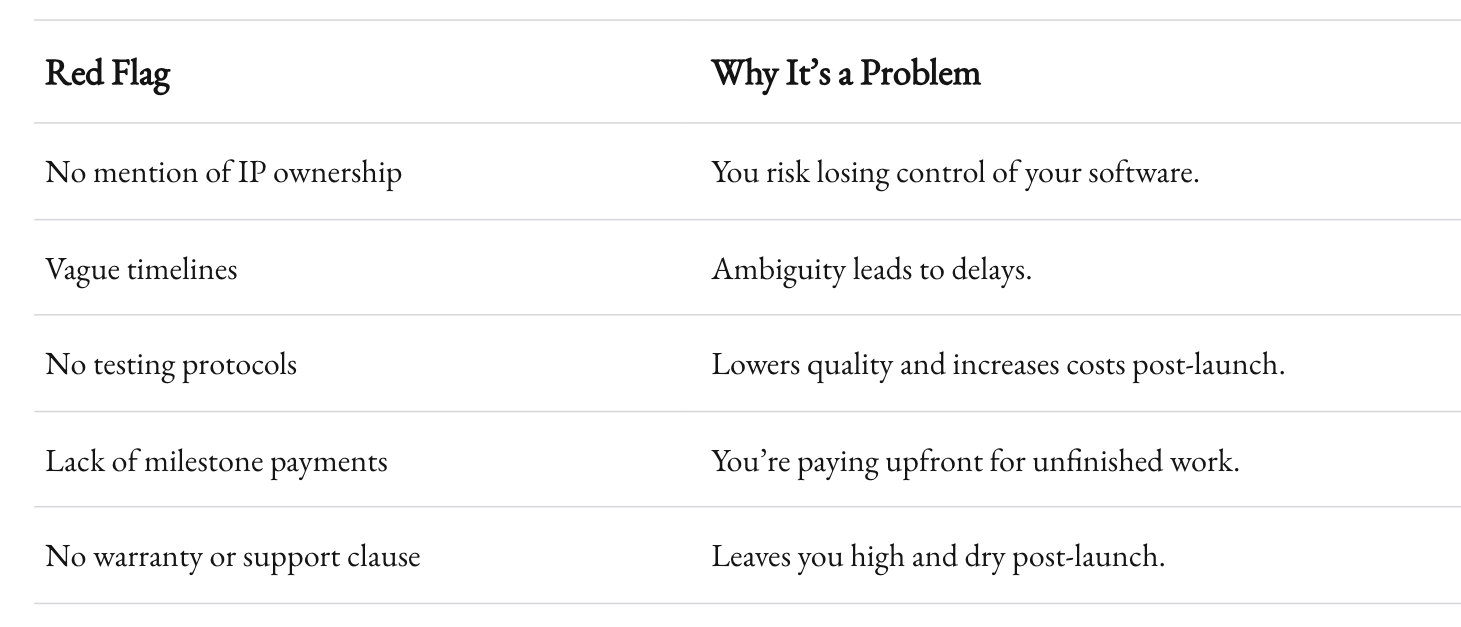Best Practices for Contract Negotiation with Software Development Firms
Learn the secrets to building flexible, fair, and foolproof software development agreements.

Negotiating a software development contract is a dance. It’s part strategy, part psychology, and part meticulous attention to detail. Having been in the thick of it at 1985, an outsourced software development company, I’ve seen deals succeed - and I’ve seen them derail. What makes the difference? It’s not just the terms on the paper. It’s the process, the approach, and the clarity on both sides. Let’s talk about what really works.
Start with Crystal Clear Goals
Imagine setting out on a road trip without a map. Frustrating, right? That’s what it feels like to negotiate a contract without clear goals.
Define the “Why” and the “What”
Before you dive into terms and timelines, make sure you’ve nailed down two things:
- Why you’re building this software.
- What success looks like.

Whether it’s automating internal processes, launching a customer-facing app, or building a prototype to attract investors, your goals will shape everything—from the payment structure to intellectual property clauses. Share these goals with the software firm. Alignment early on prevents disputes later.
Example
Let’s say you’re creating an app for healthcare appointment scheduling. Your primary goal might be to reduce patient no-shows by 20%. The success metric? Fully functional integrations with two major EMR systems within six months. When both parties know this, the scope becomes laser-focused, reducing ambiguity in the contract.
Avoid Scope Creep
A lack of clarity breeds scope creep. Build a scope document upfront. Get detailed. Use visuals, workflows, and user stories if necessary.

Prioritize Flexibility in Scope and Budget
Software development is inherently unpredictable. Deadlines shift. Requirements evolve. That’s why rigidity in contracts is a recipe for conflict.
The Myth of Fixed Price
A fixed-price contract sounds appealing. You pay X, you get Y. But in reality, fixed-price projects often lead to:
- Rushed delivery.
- Poorly implemented features.
- Post-launch bugs that cost more to fix.
Instead, consider a time-and-materials model or a hybrid approach. Time-and-materials allows for adjustments as the project unfolds. If you’re concerned about runaway costs, add caps or milestone-based approvals.

Pro Tip
Demand regular demos and progress updates. You’ll see where the project is headed and can recalibrate as needed. Think of it like steering a ship. Small course corrections early save massive detours later.
Pay Attention to Intellectual Property (IP) Ownership
This is where things often get sticky. If your software development firm doesn’t transfer full ownership of the code, you’re essentially renting the product. Not owning the code can:
- Restrict future modifications.
- Lock you into a single vendor.
- Create legal risks during fundraising or acquisition.
Clauses to Negotiate
- Work-for-Hire: Ensure all deliverables are classified as “work-for-hire” or explicitly transfer ownership upon payment.
- Pre-Existing IP: If the firm uses pre-existing libraries or frameworks they own, make sure you have perpetual usage rights.
- Source Code Escrow: For mission-critical software, consider an escrow agreement. This ensures access to the source code in case the vendor goes out of business.

Insist on Transparent Communication
Miscommunication is the silent killer of software projects. No amount of legal jargon can save a contract from poor communication.
Set Cadences and Channels
Agree on:
- Weekly or bi-weekly meetings to review progress.
- A primary point of contact.
- The tools you’ll use for collaboration (Slack, Jira, Notion, etc.).
Documentation Standards
Insist on thorough documentation. The best developers can articulate not just what they’re building but why they made certain choices. This will:
- Smooth transitions if you change vendors.
- Reduce onboarding time for your internal team.
- Lower the cost of future upgrades.
Build Incentives into the Payment Structure
Payment terms aren’t just a formality—they’re a lever for accountability.
Milestone-Based Payments
Break the project into logical milestones. Pay upon completion of each. For example:
- Discovery and Wireframes: 15%
- MVP Delivery: 30%
- Testing and QA: 30%
- Final Deployment: 25%
Milestone payments align incentives. The firm delivers value incrementally, and you maintain leverage.

Holdbacks for Quality Assurance
Consider a holdback clause. Withhold 10–15% of the total payment until the software passes acceptance testing. This ensures:
- A bug-free product.
- Proper attention to polish and performance.
Demand Rigorous Testing Standards
Shipping buggy software is worse than shipping late. Bugs erode user trust, inflate costs, and derail timelines.
What to Include in Your Contract
- Acceptance Criteria: Define what constitutes “working” software. Be explicit.
- Testing Protocols: Insist on unit tests, integration tests, and user acceptance testing (UAT).
- Bug Fix SLAs: Specify how quickly the firm must address critical issues. For example:
- Critical bugs: Fixed within 24 hours.
- Major bugs: Fixed within 3 business days.

Plan for the Long Haul
Software isn’t “one and done.” Maintenance, updates, and new features are inevitable. A short-sighted contract can leave you stranded.
Support and Maintenance
Ask:
- What’s included in post-launch support?
- How are bug fixes handled after the warranty period?
- Will the team assist with scaling if user adoption grows faster than expected?
Escaping Vendor Lock-In
Protect yourself by negotiating:
- Source Code Access: Ensure you’ll receive the full source code and related assets upon project completion.
- Documentation Transfer: This includes architecture diagrams, database schemas, and any API keys.
- Knowledge Handover: A formal knowledge transfer process ensures your internal team (or a new vendor) can pick up where the old team left off.

Red Flags to Watch Out For
Sometimes, it’s not what’s in the contract but what’s missing. Keep an eye out for:

The Human Element
At the end of the day, a contract is only as good as the people behind it. Choose a software development firm that values partnership over transactions. Look for:
- Proactive Communication: Do they raise potential risks upfront?
- Cultural Fit: Do they share your work ethic and values?
- Technical Credibility: Have they delivered similar projects successfully?
Negotiating a software development contract is a blend of art and science. Be clear about your goals. Build flexibility into the scope and budget. Insist on IP ownership and rigorous testing. And, most importantly, foster an open, transparent relationship with the firm you’re hiring.
Get the contract right, and you’ll lay the foundation for a partnership that delivers—not just a piece of software, but real, tangible value.



